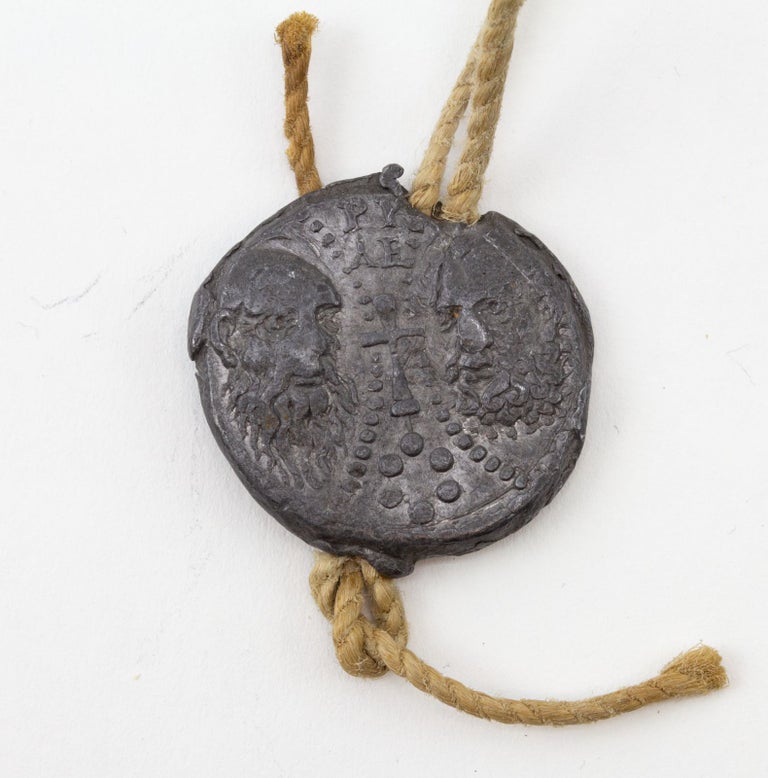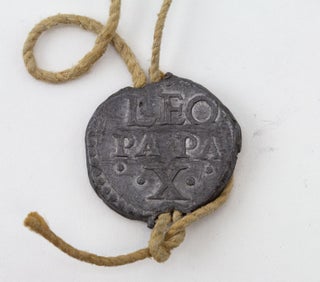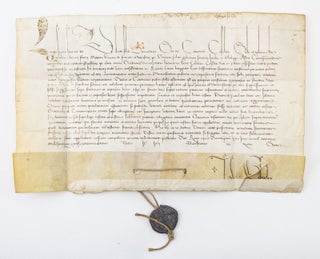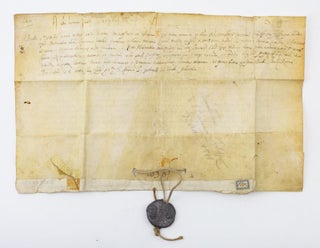CONCERNING THE DISPUTED USE OF LAND LEGALLY OWNED BY THE MONASTERY OF SAINTS GIACOMO AND FILIPPO IN THE ITALIAN CITY OF ASTI.
(Rome: 13 July 1518). 225 x 336 mm. (8 3/4 x 14 3/8"). Single column, 18 lines in a papal documentary script.
WITH THE LEAD BULLA ATTACHED BY THE ORIGINAL HEMP, AS ISSUED. With several notes in contemporary or later hands, one in top margin and the others on verso. ◆Ink in large initial and along folds a little rubbed or faded (as expected), top edge of Leo's "L" just grazed when vellum trimmed (though ample margins everywhere else), crack in vellum at very bottom right repaired (though not entirely successfully) with tape and a paper strip (with the signature of the notary partly obscured), otherwise quite fine, with the text of the document entirely clear and clean, and with the original bulla showing only minor wear.
Issued by Pope Leo X, this bull rules on a dispute relating to the alleged illegal use of lands owned by the Monastery of Saints Giacomo and Filippo in Asti. After a long judicial process in the ecclesiastical jurisdiction, the bull confirms three previous determinations regarding the usufruct (i.e., the right to use and enjoy the advantages of another's property, so long as it is well maintained) of monastery lands by a community of inhabitants in Calliano (an area about six miles from Asti). The bull rules in favor of the monastery, and points out that the convicted parties had submitted false testimony during the judicial process. They are thus ordered to assume the costs of the process and, in addition, return to the monastery the benefits illegally obtained from the land in dispute. The bull is addressed to the ecclesiastical authority that must carry out the papal sentence, namely Bernardino Strocio, canon of Casale Monferrato, and signed by P. Gabrielis, an apostolic secretary, who validates the papal writing (a common practice in this kind of document). That person is almost certainly Pietro Gabrielli da Fano, secretary to Leo X, and brother of the influential cardinal Gabrielle de' Gabrielli (1445-1511), bishop of Urbino. Pope Leo X (1475-1521) was born Giovanni di Lorenzo de' Medici, the second son of Lorenzo de' Medici, the powerful banker, statesman, and patron of the arts. During his reign (1513-21), Leo spent money lavishly and authorized the sale of indulgences to help pay the debts being constantly accrued by the papal treasury. According to the Catholic Encyclopedia, "the large treasure left by [the preceding pope] Julius II was entirely dissipated in two years." These abuses helped to fuel the Reformation, a movement that gained even more momentum with the expansion of Martin Luther's ideas expounded in his "Ninety-Five Theses," published in 1517. The Papal Bull takes its name from the lead seals, called "bullae," that were issued with official documents of the papacy as a way of ensuring their authenticity. Apart from the very rare Solemn Privilege (like Innocent III's famous granting of England in 1214 to his involuntary vassal King John), there are three categories of Papal Bulls: Simple Privileges (also called Solemn Letters), Letters of Grace (which confirm privileges and rights, but are somewhat smaller), and Mandates, which are differentiated by their use of hemp ties as opposed to silk, as here. This bull is a very relevant document for the study of economical, ecclesiastical, and jurisdictional issues in the Italian region of Piamonte, as well as for the understanding of papal bureaucracy, ecclesiastical administration, and regional social history of northern Italy. Other copies of this document are unknown, and no edited works that transcribe or analyze it have been identified. Our thanks go to Dr. Roberto Casazza for his work on translating and interpreting this document. (ST18258)
Price: $6,500.00




